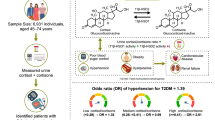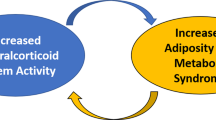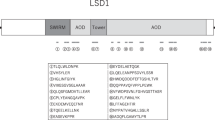Abstract
Aldosterone, the most important mineralocorticoid, regulates electrolyte excretion and intravascular volume mainly through its effects on renal distal tubules and cortical collecting ducts, where it acts to increase sodium resorption from and potassium excretion into the urine. Excess secretion of aldosterone or other mineralocorticoids, or abnormal sensitivity to mineralocorticoids, may result in hypokalemia, suppressed plasma renin activity, and hypertension. The syndrome of apparent mineralocorticoid excess(AME) is an inherited form of hypertension in which 11β-hydroxysteroid dehydrogenase (11β-HSD) is defective. This enzyme converts cortisol to its inactive metabolite, cortisone. Because mineralocorticoid receptors themselves have similar affinities for cortisol and aldosterone, it is hypothesized that the deficiency allows these receptors to be occupied by cortisol, which normally circulates at levels far higher than those of aldosterone. We cloned cDNA and genes encoding two isozymes of 11β-HSD. The liver (L) or type 1 isozyme has relatively low affinity for steroids, is expressed at high levels in the liver but poorly in the kidney, and is not defective in AME. The kidney (K) or type 2 isozyme has high steroid affinity and is expressed at high levels in the kidney and placenta. Mutations in the gene for the latter isozyme have been detected in all kindreds with AME. Moreover, the in vitro enzymatic activity conferred by each mutation is strongly correlated with the ratio of cortisol to cortisone metabolites in the urine [tetrahydrocortisone (THF) + allo-THF]/THE. This suggests that the biochemical phenotype of AME is largely determined by genotype.
Similar content being viewed by others
Log in or create a free account to read this content
Gain free access to this article, as well as selected content from this journal and more on nature.com
or
Abbreviations
- AME:
-
apparent mineralocorticoid excess
- HSD:
-
hydroxysteroid dehydrogenase
- THF:
-
tetrahydrocortisol
- THE:
-
tetrahydrocortisone
References
White PC 1994 Disorders of aldosterone biosynthesis and action. N Engl J Med 331: 250–258.
White PC, Curnow KM, Pascoe L 1994 Disorders of steroid 11β- hydroxylase isozymes. Endocr Rev 15: 421–438.
Ulick S, Levine LS, Gunczler P, Zanconato G, Ramirez LC, Rauh W, Rosler A, Bradlow HL, New MI 1979 A syndrome of apparent mineralocorticoid excess associated with defects in the peripheral metabolism of cortisol. J Clin Endocrinol Metab 49: 757–764.
Oberfield SE, Levine LS, Carey RM, Greig F, Ulick S, New MI 1983 Metabolic and blood pressure responses to hydrocortisone in the syndrome of apparent mineralocorticoid excess. J Clin Endocrinol Metab 56: 332–339.
Shackleton CH, Rodriguez J, Arteaga E, Lopez JM, Winter JS 1985 Congenital 11β-hydroxysteroid dehydrogenase deficiency associated with juvenile hypertension: corticosteroid metabolite profiles of four patients and their families. Clin Endocrinol 22: 701–712.
Monder C, Shackleton CH, Bradlow HL, New MI, Stoner E, Iohan F, Lakshmi V 1986 The syndrome of apparent mineralocorticoid excess: its association with 11β-dehydrogenase and 5β-reductase deficiency and some consequences for corticosteroid metabolism. J Clin Endocrinol Metab 63: 550–557.
Stewart PM, Wallace AM, Valentino R, Burt D, Shackleton CH, Edwards CR 1987 Mineralocorticoid activity of liquorice: 11β-hydroxysteroid dehydrogenase deficiency comes of age. Lancet 2: 821–824.
Monder C, Stewart PM, Lakshmi V, Valentino R, Burt D, Edwards CR 1989 Licorice inhibits corticosteroid 11β-dehydrogenase of rat kidney and liver: in vivo and in vitro studies. Endocrinology 125: 1046–1053.
Arriza JL, Weinberger C, Cerelli G, Glaser TM, Handelin BL, Housman DE, Evans RM 1987 Cloning of human mineralocorticoid receptor complementary DNA: structural and functional kinship with the glucocorticoid receptor. Science 237: 268–275.
Krozowski ZS, Funder JW 1983 Renal mineralocorticoid receptors and hippocampal corticosterone binding species have identical intrinsic steroid specificity. Proc Natl Acad Sci USA 80: 6056–6060.
Edwards CR, Stewart PM, Burt D, Brett L, McIntyre MA, Sutanto WS, de Kloet ER, Monder C 1988 Localisation of 11β-hydroxysteroid dehydrogenase-tissue-specific protector of the mineralocorticoid receptor. Lancet 2: 986–989.
Funder JW, Pearce PT, Smith R, Smith AI 1988 Mineralocorticoid action: target tissue specificity is enzyme, not receptor, mediated. Science 242: 583–585.
Lakshmi V, Monder C 1988 Purification and characterization of the corticosteroid 11β-dehydrogenase component of the rat liver 11β-hydroxysteroid dehydrogenase complex. Endocrinology 123: 2390–2398.
Agarwal AK, Monder C, Eckstein B, White PC 1989 Cloning and expression of rat cDNA encoding corticosteroid 11β-dehydrogenase. J Biol Chem 264: 18939–18943.
Agarwal AK, Tusie-Luna MT, Monder C, White PC 1990 Expression of 11 betahydroxysteroid dehydrogenase using recombinant vaccinia virus. Mol Endocrinol 4: 1827–1832.
Tannin GM, Agarwal AK, Monder C, New MI, White PC 1991 The human gene for 11β-hydroxysteroid dehydrogenase. Structure, tissue distribution, and chromosomal localization. J Biol Chem 266: 16653–16658.
Nikkila H, Tannin GM, New MI, Taylor NF, Kalaitzoglou G, Monder C, White PC 1993 Defects in the HSD11 gene encoding 11β-hydroxysteroid dehydrogenase are not found in patients with apparent mineralocorticoid excess or 11-oxoreductase deficiency. J Clin Endocrinol Metab 77: 687–691.
Yang K, Smith CL, Dales D, Hammond GL, Challis JR 1992 Cloning of an ovine 11β-hydroxysteroid dehydrogenase complementary deoxyribonucleic acid: tissue and temporal distribution of its messenger ribonucleic acid during fetal and neonatal development. Endocrinology 131: 2120–2126.
Rundle SE, Funder JW, Lakshmi V, Monder C 1989 The intrarenal localization of mineralocorticoid receptors and 11β-dehydrogenase: immunocytochemical studies. Endocrinology 125: 1700–1704.
Rusvai E, Naray-Fejes-Toth A 1993 A new isoform of 11β-hydroxysteroid dehydrogenase in aldosterone target cells. J Biol Chem 268: 10717–10720.
Brown RW, Chapman KE, Edwards CR, Seckl JR 1993 Human placental 11 beta-hydroxysteroid dehydrogenase: evidence for and partial purification of a distinct NAD-dependent isoform. Endocrinology 132: 2614–2621.
Brown RW, Chapman KE, Murad P, Edwards CR, Seckl JR 1996 Purification of 11β-hydroxysteroid dehydrogenase type 2 from human placenta utilizing a novel affinity labelling technique. Biochem J 313: 997–1005.
Agarwal AK, Mune T, Monder C, White PC 1994 NAD+-dependent isoform of 11β-hydroxysteroid dehydrogenase: cloning and characterization of cDNA from sheep kidney. J Biol Chem 269: 25959–25962.
Albiston AL, Obeyesekere VR, Smith RE, Krozowski ZS 1994 Cloning and tissue distribution of the human 11-HSD type 2 enzyme. Mol Cell Endocrinol 105:R11–R17.
Wu L, Einstein M, Geissler WM, Chan HC, Elliston KO, Andersson S 1993 Expression cloning and characterization of human 17β-hydroxysteroid dehydrogenase type 2, a microsomal enzyme possessing 20α-hydroxysteroid dehydrogenase activity. J Biol Chem 268: 12964–12969.
Persson B, Krook M, Jornvall H 1991 Characteristics of short-chain alcohol dehydrogenases and related enzymes. Eur J Biochem 200: 537–543.
Obeid J, White PC 1992 Tyr-179 and Lys-183 are essential for enzymatic activity of 11β-hydroxysteroid dehydrogenase. Biochem Biophys Res Commun 188: 222–227.
Ghosh D, Weeks CM, Grochulski P, Duax WL, Erman M, Rimsay RL, Orr JC 1991 Three-dimensional structure of holo 3α,20β-hydroxysteroid dehydrogenase: a member of a short-chain dehydrogenase family. Proc Natl Acad Sci USA 88: 10064–10068.
Agarwal AK, Rogerson FM, Mune T, White PC 1995 Gene structure and chromosomal localization of the human HSD11K gene encoding the kidney (type 2) isozyme of 11β-hydroxysteroid dehydrogenase. Genomics 29: 195–199.
Mune T, Rogerson FM, Nikkila H, Agarwal AK, White PC 1995 Human hypertension caused by mutations in the kidney isozyme of 11β-hydroxysteroid dehydrogenase. Nat Genet 10: 394–399.
Wilson RC, Krozowski ZS, Li K, Obeyesekere VR, Razzaghy-Azar M, Harbison MD, Wei JQ, Shackleton CH, Funder JW, New MI 1995 A mutation in the HSD11B2 gene in a family with apparent mineralocorticoid excess. J Clin Endocrinol Metab 80: 2263–2266.
Wilson RC, Harbison MD, Krozowski ZS, Funder JW, Shackleton CH, Hanauske-Abel HM, Wei JQ, Hertecant J, Moran A, Neiberger RE, Balfe JW, Fattah A, Daneman D, Licholai T, New MI 1995 Several homozygous mutations in the gene for 11β-hydroxysteroid dehydrogenase type 2 in patients with apparent mineralocorticoid excess. J Clin Endocrinol Metab 80: 3145–3150.
Stewart PM, Krozowski ZS, Gupta A, Milford DV, Howie AJ, Sheppard MC, Whorwood CB 1996 Hypertension in the syndrome of apparent mineralocorticoid excess due to mutation of the 11β-hydroxysteroid dehydrogenase type 2 gene. Lancet 347: 88–91.
Mune T, White PC 1996 Apparent mineralocorticoid excess: genotype is correlated with biochemical phenotype. Hypertension 27: 1193–1199.
Obeyesekere VR, Ferrari P, Andrews RK, Wilson RC, New MI, Funder JW, Krozowski ZS 1995 The R337C mutation generates a high Km 11β-hydroxysteroid dehydrogenase type II enzyme in a family with apparent mineralocorticoid excess. J Clin Endocrinol Metab 80: 3381–3383.
Tusie-Luna MT, Traktman P, White PC 1990 Determination of functional effects of mutations in the steroid 21-hydroxylase gene(CYP21) using recombinant vaccinia virus. J Biol Chem 265: 20916–20922.
Gruol DJ, Bourgeois S 1994 Expression of the mdr1 P-glycoprotein gene: a mechanism of escape from glucocorticoid-induced apoptosis. Biochem Cell Biol 72: 561–571.
Author information
Authors and Affiliations
Additional information
Supported by National Institutes of Health Grant DK42169.
Rights and permissions
About this article
Cite this article
White, P., Mune, T., Rogerson, F. et al. 11β-Hydroxysteroid Dehydrogenase and Its Role in the Syndrome of Apparent Mineralocorticoid Excess. Pediatr Res 41, 25–29 (1997). https://doi.org/10.1203/00006450-199701000-00004
Issue date:
DOI: https://doi.org/10.1203/00006450-199701000-00004
This article is cited by
-
Colfibrate attenuates blood pressure and sodium retention in DOCA-salt hypertension
Kidney International (2008)



